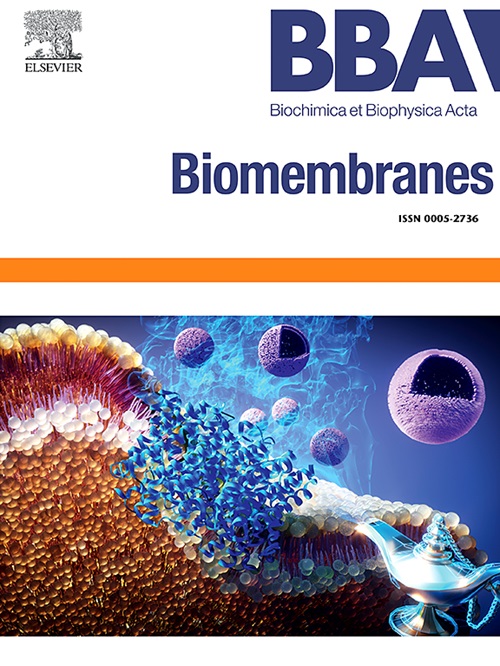脂质饱和度对苯乙烯马来酸脂质纳米颗粒(SMALPs)结构性能的影响。
IF 2.5
3区 生物学
Q3 BIOCHEMISTRY & MOLECULAR BIOLOGY
引用次数: 0
摘要
膜双分子层是复杂的三维结构,其深层膜脂分子事件对理解膜功能至关重要。本研究利用苯乙烯-马来酸(SMA)共聚物作为膜模拟物,研究了共存膜结构域在疏水性、烷基链序和流动性方面的相互作用。我们采用连续波电子顺磁共振波谱(CW-EPR)来表征无分离膜结构域的结构动力学特性。采用不同饱和度的磷脂(DOPC、POPC、DMPC和dsc)和不同深度的羟基自旋标记磷脂(5、12和16-羟基PC)作为膜探针制备脂质自旋探针囊泡。用两种不同疏水尾长度的SMA聚合物滴定这些囊泡。动态光散射(DLS)证实了苯乙烯马来酸脂质纳米颗粒(SMALPs)的形成。采用CW-EPR光谱法表征了加入到smallp系统中的囊泡的动态特性。w - epr谱线形状数据分析表明,SMA疏水尾部、脂质饱和程度和磷脂长度显著影响膜流动性、烷基链排序以及脂质相互作用。值得注意的是,含有dsc(一种完全饱和的长链磷脂)的样品和含有SMA的样品表现出运动刚性增加,流动性降低,并改善了膜中烷基链的有序性。这项研究为膜双层的分子动力学和SMA共聚物对膜性能的影响提供了重要的见解,有助于我们理解基本的膜功能,如蛋白质和脂质的横向运动。本文章由计算机程序翻译,如有差异,请以英文原文为准。

Influence of lipid saturation on the structural properties of styrene maleic acid lipid nanoparticles (SMALPs)
Membrane bilayers are complex three-dimensional structures whose molecular events in the deep dimensions of membrane lipids are crucial for understanding membrane function. This study investigates the interaction of coexisting membrane domains in terms of hydrophobicity, alkyl chain order, and fluidity using Styrene Maleic Acid (SMA) copolymers as membrane mimics. We employed continuous wave electron paramagnetic resonance spectroscopy (CW-EPR) to characterize the structural dynamic properties of membrane domains without separation. Lipid-spin probe vesicles were prepared using phospholipids with varying degrees of saturation (DOPC, POPC, DMPC, and DSPC) and doxyl spin-labeled phospholipids at different depths (5, 12, and 16-doxyl PC) as membrane probes. These vesicles were titrated with two SMA polymers of different hydrophobic tail lengths. Dynamic light scattering (DLS) confirmed the formation of Styrene Maleic Acid lipid nanoparticles (SMALPs). CW-EPR spectroscopy was used to characterize the dynamic properties of vesicles incorporated into the SMALP systems. Analysis of the CW-EPR spectral line shape data revealed that the hydrophobic tail of SMA, the degree of lipid saturation, and the length of phospholipids significantly affect membrane fluidity and alkyl chain ordering, as well as lipid interactions. Notably, samples containing DSPC, a fully saturated longer-chain phospholipid, and those containing SMA exhibited increased rigidity of motion, reduced fluidity, and improved ordering of the alkyl chain in the membrane. This study provides crucial insights into the molecular dynamics of membrane bilayers and the impact of SMA copolymers on membrane properties, contributing to our understanding of fundamental membrane functions such as lateral movement of proteins and lipids.
求助全文
通过发布文献求助,成功后即可免费获取论文全文。
去求助
来源期刊

Biochimica et biophysica acta. Biomembranes
生物-生化与分子生物学
CiteScore
8.20
自引率
5.90%
发文量
175
审稿时长
2.3 months
期刊介绍:
BBA Biomembranes has its main focus on membrane structure, function and biomolecular organization, membrane proteins, receptors, channels and anchors, fluidity and composition, model membranes and liposomes, membrane surface studies and ligand interactions, transport studies, and membrane dynamics.
 求助内容:
求助内容: 应助结果提醒方式:
应助结果提醒方式:


